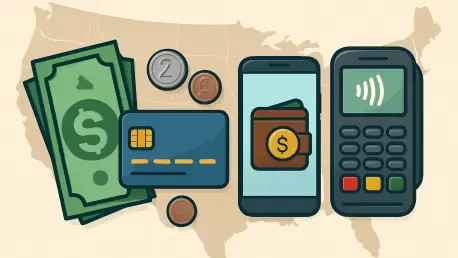The U.S. payment gateways market is experiencing a transformative surge, with projections estimating growth from a substantial $5.8 billion in 2024 to an impressive $8.8 billion by 2033, reflecting a steady compound annual growth rate (CAGR) of 4.37% over the forecast period. This remarkable trajectory is fueled by a seismic shift in consumer behavior toward digital payments, driven by the convenience of online shopping and mobile transactions. As e-commerce continues to reshape the retail landscape, the demand for secure, efficient, and scalable payment solutions has never been more critical. Digital wallets, for instance, saw a striking 32% increase in usage in recent years, particularly among younger demographics like Millennials and Gen Z, with a vast majority viewing mobile payment options as indispensable. This trend underscores the pivotal role payment gateways play in the digital economy, acting as the backbone for seamless transactions while businesses race to adapt to evolving customer expectations and technological advancements.
Forces Propelling Market Expansion
The meteoric rise of e-commerce stands as a primary driver behind the robust growth of the U.S. payment gateways market, fundamentally altering how businesses operate in a digital-first world. With retail e-commerce sales reaching a staggering $289.2 billion in the first quarter of 2024 alone, accounting for nearly 16% of total retail sales, the necessity for reliable payment systems has become undeniable. Companies, from sprawling enterprises to nimble startups, are compelled to integrate payment gateways that can manage high transaction volumes while ensuring top-tier security and seamless platform compatibility. This surge in online shopping not only amplifies the need for efficient transaction processing but also pushes providers to innovate continuously, creating systems that enhance user experience and safeguard against potential disruptions in the increasingly crowded digital marketplace.
Another significant factor fueling this market’s ascent is the rapid adoption of payment gateways by small and medium-sized enterprises (SMEs), which form a critical segment of the U.S. economy. These businesses, contributing a substantial share to national exports, are increasingly turning to digital payment solutions to broaden their market reach and streamline operations in an era of heightened consumer demand for convenience. Payment gateways offer the infrastructure necessary to support this digital transition, enabling SMEs to compete on a larger scale by providing secure and accessible transaction options. Beyond mere functionality, these systems help build consumer trust—a cornerstone of sustained growth—while allowing smaller players to tap into global markets with relative ease, thus driving the overall market forward at an accelerated pace.
Navigating Challenges in a Digital Era
While the outlook for the U.S. payment gateways market remains overwhelmingly positive, it is not without its share of obstacles, particularly in the realm of regulatory compliance. Providers must grapple with a labyrinth of federal and state regulations surrounding data protection and financial transactions, a task that often results in elevated operational costs and added complexity. Staying abreast of evolving legal frameworks while maintaining seamless service delivery poses a significant challenge, especially for smaller firms with limited resources. Despite these hurdles, the industry continues to adapt through strategic planning and investment in compliance technologies, ensuring that consumer data remains protected while meeting stringent standards that vary across jurisdictions.
On the flip side, the challenges are vastly outweighed by the abundant opportunities presented by an increasingly digital economy, where consumer demand for frictionless payment experiences reigns supreme. The ongoing digitalization of commerce offers fertile ground for innovation, with payment gateway providers poised to capitalize on emerging trends such as contactless payments and integrated financial ecosystems. As businesses of all sizes pivot to meet these demands, the market stands to benefit from tailored solutions that address specific pain points, from transaction speed to cross-border capabilities. This dynamic environment fosters a culture of resilience and adaptability, positioning the industry to overcome regulatory and operational barriers while unlocking new avenues for growth and customer engagement.
Diverse Segments and Regional Dynamics
The U.S. payment gateways market reveals a rich tapestry of diversity when segmented by application and mode of interaction, each category highlighting unique growth patterns and business needs. Applications span across large enterprises, mid-size businesses, and SMEs, with the latter emerging as a powerhouse of growth due to their swift embrace of digital payment solutions to fuel e-commerce expansion. Meanwhile, modes of interaction—ranging from hosted payment gateways to API-based and platform-driven systems—cater to varying technical and scalability requirements. Hosted and platform-based options, in particular, are gaining traction for their user-friendly integration, allowing businesses to minimize technical burdens while delivering smooth payment experiences to customers across multiple touchpoints.
Regionally, the market showcases distinct dynamics, with the Northeast standing out as a dominant force thanks to its concentration of fintech innovation and major financial hubs like New York and Boston. High population density and elevated income levels in this area bolster a thriving e-commerce ecosystem, driving demand for cutting-edge payment solutions. However, other regions such as the Midwest, South, and West are also carving out their own growth paths, influenced by local economic conditions and technology adoption rates. These regional variations underscore the importance of customized approaches for payment gateway providers, ensuring that solutions align with specific demographic and economic realities while contributing to the broader national market expansion through 2033.
Innovation and Competitive Strategies
The competitive landscape of the U.S. payment gateways market is marked by fierce rivalry among industry leaders who are relentlessly pushing the boundaries of innovation to maintain their edge. Major players like PayPal, Stripe, and Dwolla are at the forefront, consistently rolling out advanced solutions to address the nuanced needs of consumers and businesses alike. For instance, recent initiatives such as PayPal’s introduction of Tap to Pay on iPhone have simplified contactless transactions, while Stripe’s strategic alliances with retail brands aim to enhance both online and in-store payment experiences. These efforts reflect a broader industry trend toward prioritizing user convenience and transaction efficiency in an increasingly fast-paced digital environment.
Beyond individual advancements, the market is shaped by a collective drive toward integrating cutting-edge technologies like artificial intelligence (AI) and machine learning (ML) into payment systems, significantly bolstering fraud detection and risk management capabilities. Real-time transaction analysis powered by these technologies not only enhances security but also fosters greater consumer confidence in digital payments—a crucial element for sustained market growth. As companies forge strategic partnerships and invest heavily in research and development, the emphasis on adaptability becomes clear, ensuring that the industry remains responsive to rapid technological shifts and evolving consumer preferences, setting the stage for continued innovation through the forecast period.
Shaping the Future of Digital Transactions
Reflecting on the trajectory of the U.S. payment gateways market, it has become evident that the industry has solidified its position as a cornerstone of the digital economy by overcoming early challenges with remarkable resilience. By 2024, the market had already achieved a valuation of $5.8 billion, setting a strong foundation for the projected climb to $8.8 billion by 2033. The relentless push toward digital payments, underpinned by soaring e-commerce sales and widespread adoption of mobile transactions, has reshaped financial interactions across the nation. Looking ahead, stakeholders are encouraged to focus on fostering innovation through AI-driven security enhancements and user-centric solutions. Collaboration between businesses and regulators could further streamline compliance processes, reducing friction while maintaining robust data protection. As the digital landscape continues to evolve, prioritizing scalable and adaptable payment systems will be key to sustaining growth and meeting the ever-changing demands of a tech-savvy consumer base.









